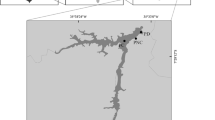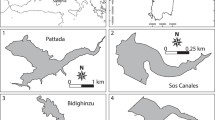Abstract
The biological interactions and the physical and chemical properties of the littoral zone of Lake Krugersdrift were studied for a 4-month period when a dense, toxic cyanobacterial bloom dominated by Microcystis aeruginosa was present in the main lake basin. The presence of a toxic strain of M. aeruginosa was confirmed through the use of ELISA and molecular markers that detect the presence of the mcyB and mcyD genes of the mcy gene cluster that synthesizes microcystin. An increase in Microcystis toxicity at sites dominated by the cyanobacterial scum was accompanied by an increase in total abundance of the macroinvertebrate families Hirudinae, Chironomidae, and Tubificidae. Sites located away from the cyanobacterial scum had a lower abundance but a higher diversity of macroinvertebrates. The water quality under the Microcystis scum was characterized by low pH values, low concentrations of dissolved oxygen, and lower total alkalinity values. The periphytic alga Ulothrix zonata was absent in areas dominated by the cyanobacterial scum, possibly as a result of overshadowing by the scum or direct toxic allelopathic effects on growth and photosynthesis. The diatom Diatoma vulgare dominated the benthic algal flora beneath the cyanobacterial scum.






Similar content being viewed by others
References
Allanson BR, Hart RC, O’Keeffe JH, Robarts RD (1990) Inland waters of Southern Africa: an ecological perspective. Kluwer Academic Publishers, Dordrecht
Allen JD (1995) Stream ecology. Chapman and Hall, London, pp 1–338
American Public Health Association (APHA), American Water Works Association (AWWA), and Water Pollution Control Federation (WPCF) (1980) Standard methods for the examination of water and wastewater, 15th edn. American Public Health Association, Washington, DC
American Public Health Association (APHA) (1989) Standard methods for the examination of water and wastewater, 17th edn. American Public Health Association, Washington, DC
Bagchi SN, Palod A, Chaunan VS (1990) Algicidal properties of a bloom forming blue-green alga, Oscillatoria sp. J Basic Microbiol 30:21–29. doi:10.1002/jobm.3620300106
Ball RC, Bahr TG (1975) Intensive survey: Red Cedar River, Michigan. In: Whitton BA (ed) River ecology. Blackwell, Oxford, pp 431–460
Beattie KA, Kaya K, Codd GA (2000) The cyanobacterium Nodularia PCC 7804, of freshwater origin, produces [L-Har2] nodularin. Phytochemistry 54:57–61
Berger WH, Parker FL (1970) Diversity of planktonic Foraminifera in deep sea sediments. Science 168:1345–1347. doi:10.1126/science.168.3937.1345
Botha-Oberholster A-M, Oberholster PJ (2007) PCR based markers for detection and identification of toxic cyanobacteria. WRC Report No. 1502/1/07. Water Research Commission, Pretoria, pp 1–58
Boyer GL, Satchwell MF, Shambaugh A, Watzin M, Mihuc TB, Rosen B (2004) The occurrence of cyanobacterial toxins in Lake Champlain Waters. In: Manley T, Manley P, Mihuc TB (eds) Lake Champlain: partnerships and research in the new millennium. Kluwer Academic Press, Dordrecht, pp 241–257
Carmichael WW (1994) The toxins of cyanobacteria. Sci Am 270:78–86
Carter-Lund H, Lund JWG (1995) Freshwater algae—their microscopic world explored. Biopress Ltd, pp 1–360
Chong MWK, Wong PKS, Shaw GR, Seawright AA (2002) Toxicity and uptake mechanism of cylindrospermopsin and lophyrotomin in primary rat hepatocytes. Toxicon 40:205–211. doi:10.1016/S0041-0101(01)00228-8
Codd GA, Metcalf JS, Beattie KA (1999) Retention of Microcystis aeruginosa and microcystin by salad (Lactuca sativa) after spray irrigation with water containing cyanobacteria. Toxicon 37:1181–1185. doi:10.1016/S0041-0101(98)00244-X
Figueredo CC, Giani A (2001) Seasonal variations in the diversity and species richness of phytoplankton in a tropical eutrophic reservoir. Hydrobiologia 445:165–174. doi:10.1023/A:1017513731393
Gausch H, Ivorra N, Lehmann V, Paulsson M, Real M, Sabater T (1998) Community composition and sensitivity of periphyton to atrazine in flowing waters: the role of environmental factors. J Appl Phycol 10:203–213. doi:10.1023/A:1008035212208
Grobbelaar JU (1985) Phytoplankton productivity in turbid waters. J Plankton Res 7:653–663. doi:10.1093/plankt/7.5.653
Grobbelaar JU (1992) Nutrient versus physical factors in determining the primary productivity of waters with high inorganic turbidity. Hydrobiologia 238:177–182. doi:10.1007/BF00048786
Grobbelaar JU, Botes E, Van den Heever JA, Botha A-M, Oberholster PJ (2004) Scope and dynamics of toxin produced by cyanophytes in the freshwaters of South Africa and the implications for human and other users. WRC Report No: 1029/1/04. Water Research Commission, Pretoria, pp 1–9
Hellawell JM (1986) Biological indicators of freshwater pollution and environmental management. Elsevier Applied Science, London
Hisbergues M, Christiansen G, Rouhiainen L, Sivonen K, Börner T (2003) PCR-based identification of microcystin-producing genotypes of different cyanobacterial genera. Arch Microbiol 180:402–410. doi:10.1007/s00203-003-0605-9
Ikawa M, Sasner JJ, Haney JF (2001) Activity of cyanobacterial and algal odor compounds found in lake waters on green alga Chlorella pyrenoidosa growth. Hydrobiologia 443:19–22. doi:10.1023/A:1017535801766
Kaebernick M, Dittman E, Börner T, Neilan BA (2000) Multiple alternate transcripts direct the biosynthesis of microcystin, a cyanobacterial non-ribosomal peptide. Appl Environ Microbiol 68:449–455. doi:10.1128/AEM.68.2.449-455.2002
Kahlert M, Andren CM (2005) Benthic diatoms as valuable indicators of acidity. Verh Int Verein Limnol 29:635–639
Kiviranta J, Sivonen K, Lahti K, Luukkainen R (1991) Production and biodegradation of cyanobacterial toxins—a laboratory study. Arch Hydrobiol 121:281–294
Lang C (1984) Eutrophication of Lake Leman and Neuchatel (Switzerland) indicated by oligochaete communities. Hydrobiologia 114:131–138. doi:10.1007/BF00027907
MacKintosh RW, Dalby KN, Campbell DG, Codd GA (1990) Cyanobacterial microcystin-LR is a potent and specific inhibitor of protein phosphatases 1 and 2A from both mammals and higher plants. FEBS Lett 264:187–192. doi:10.1016/0014-5793(90)80245-E
Meißner K, Dittmann E, Börmer T (1996) Toxic and non-toxic strains of the cyanobacterium Microcystis aeruginosa contain sequences homologous to peptide synthetase genes. FEMS Microbiol Lett 135:295–303. doi:10.1016/0378-1097(95)00469-6
Merrit RW, Cummins KW (1996) An introduction to the aquatic insects of North America, 3rd edn. Kendal/Hunt, Dubuque, Iowa, USA
NIWR (National Institute for Water Research) (1985) The limnology of Hartbeespoort dam. South African National Scientific Programmes Report No. 110. Foundation for Research Development, Pretoria
Niyogi DK, McKnight DM, Lewis WM (1999) Influences of water and substrate quality for periphyton in a Montana stream affected by acid mine drainage. Limnol Oceanogr 44:804–809
Oberholster PJ (2004) Assessing genetic diversity and identification of Microcystis aeruginosa strains through AFLP and PCR-RFLP analysis. M.Sc. Thesis, University of the Free State, Bloemfontein, South Africa, pp 1–114
Oberholster PJ, Botha A-M (2007) Use of PCR based technologies for risk assessment of a winter cyanobacterial bloom in Lake Midmar, South Africa. Afr J Biotechnol 6:1794–1805
Oberholster PJ, Botha A-M, Cloete TE (2005a) An overview of toxic freshwater cyanobacteria in South Africa with special reference to risk, impact and detection by molecular marker tools. Biokem 17:57–71
Oberholster PJ, Botha A-M, Cloete TE (2005b) Using a battery of bioassays, benthic phytoplankton and the AUSRIVAS method to monitor long-term coal tar contaminated sediment in the Cache la Poudre River, Colorado. Water Res 39:4913–4924. doi:10.1016/j.watres.2005.08.029
Patrick R, Reimer CW (1975) The diatoms of the United States exclusive of Alaska and Hawaii, vol 2. National Academy of Sciences, Philadelphia, USA Part 1. Monograph 13
Pitois S, Jackson MH, Wood BJB (2001) Sources of the eutrophication problems associated with toxic algae: an overview. J Environ Health 64:25–32
Poole HH, Atkins WRG (1929) Photo-electric measurements of submarine illumination throughout the year. J Mar Biol Assoc UK 16:297–324
Porra RJ, Thompson WA, Kriedemann PE (1989) Determination of accurate extinction coefficients and simultaneous equations for assaying chlorophyll a and b extracted with four different solvents: verification of the concentration of chlorophyll standards by atomic absorption spectrometry. Biochim Biophys Acta 975:384–394. doi:10.1016/S0005-2728(89)80347-0
Prat N, Ward JV (1994) The tamed river. In: Margalef R (ed) Limnology now: a paradigm of planetary problems. Elsevier Science B.V.,Amsterdam, The Netherlands, pp 219–236
Republic of South Africa (1998) The National Water act (Act No. 36 of 1998) Government of the Republic of South Africa, Pretoria, South Africa
Rondel C, Arfi R, Corbn D, le Bihan F, Hadji Ndour E, Lazzaro X (2008) A cyanobacterial bloom prevents fish trophic cascades. Freshw Biol 53:637–651. doi:10.1111/j.1365-2427.2007.01894.x
Shannon CE, Weaver W (1949) The mathematical theory of communications. University of Illinois Press, Urbana
Strayer D (1985) The benthic micrometazoans of Mirror Lake, New Hampshire. Arch Hydrobiol 72:287–426
Sukenik A, Eshkol RL, Hadas O (2002) Inhibition of growth and photosynthesis of the Dinoflagellate Peridinium gatunense by Microcystis sp. (cyanobacteria): a novel allelopathic mechanism. Limnol Oceanogr 47:1656–1663
SYSTAT (1997) Systat® 7.0.1 for Windows®: Statistics. SPSS Inc, Chicago, USA
Thorp JH, Covich AP (2001) Ecology and classification of North American freshwater invertebrates. Academic Press, San Diego, California, USA, pp 1–775
Tillett D, Parker DL, Neilan BA (2001) Detection of toxigenicity by a probe for the microcystin synthetase A gene (mcyA) of the cyanobacterial genus Microcystis: comparison of toxicities with 16S rRNA and phycocyanin operon (phycocyanin intergenic spacer) phylogenies. Appl Environ Microbiol 67:2810–2818. doi:10.1128/AEM.67.6.2810-2818.2001
Ueno Y, Nagata S, Tsutsumi T, Hasegawa A, Yoshida F, Suttajit M et al (1996) Survey of microcystins in environmental water by a highly sensitive immunoassay based on monoclonal antibody. Nat Toxins 4:271–276
Van Ginkel CE (2004) A national survey of the incidence of cyanobacterial blooms and toxin produced in major impoundments. Internal Report No. N/000/00/DEQ/0503. Resource Quality Services, Department of Water Affairs and Forestry, Pretoria, pp 1–44
Van Ginkel CE, Hohls BC, Belcher E, Vermaak E, Gerber A (2001) Assessment of the Trophic Status Project. Internal report No. N/0000/00/DEQ/1799. Institute for Water Quality Studies, Department of Water Affairs and Forestry, Pretoria, pp 1–334
Van Ginkel CE, Silberbauer MJ, Vermaak E (2000) The seasonal and spatial distribution of cyanobacteria in South African surface waters. Verh Int Verein Limnol 27:871–878
Voelz NJ, Ward JV (1991) Biotic responses along the recovery gradient of a regulated stream. Can J Fish Aquat Sci 48:2477–2490. doi:10.1139/f91-289
Von Brand T (1944) Occurrence of anaerobiosis among invertebrates. Biodynamica 4:185–328
Walmsley RD, Butty M, Van Der Piepen H, Grobler DC (1980) Light penetration and the interrelationships between optical parameters in a turbid subtropical impoundment. Hydrobiologia 70:145–157. doi:10.1007/BF00015500
Watson SB, Brownlee B, Satchwill T, Hargesheimer EE (2000) Quantitative analysis of trace levels of geosmin and MIB in source and drinking water using headspace SPME. Water Res 34:2818–2828. doi:10.1016/S0043-1354(00)00027-0
Wehr JD, Sheath RG (2001) Freshwater algae of North America, ecology and classification. Academic Press, San Diego, USA, pp 775–804
White SH, Duivenvoorden LJ, Fabbro LD (2005) Impacts of a toxic Microcystis bloom on the macroinvertebrate fauna of Lake Elphinstone, Central Queensland, Australia. Hydrobiologia 548:117–126. doi:10.1007/s10750-005-4756-3
Wiegand C, Pflugmacher S (2005) Ecotoxicological effects of selected cyanobacterial secondary metabolites—a short review. Toxicol Appl Pharmacol 203:201–218. doi:10.1016/j.taap.2004.11.002
Willen E (1976) A simplified method of phytoplankton counting. Br Phycol J 11:265–278. doi:10.1080/00071617600650551
Willen E (1991) Planktonic diatoms—an ecological review. Algol Stud 62:69–106 Stuttgart, Augustus 1991
Winter JG, Dillon PJ, Paterson C, Reid RA, Somers KM (2003) Impacts of golf course construction and operation on headwater streams: bioassessment using benthic algae. Can J Bot 81:848–858. doi:10.1139/b03-081
Zohary T (1985) Hyperscum of the cyanobacterium Microcystis aeruginosa in a hypertrophic lake (Hartbeespoort Dam, South Africa). J Plankton Res 7:399–409. doi:10.1093/plankt/7.3.399
Author information
Authors and Affiliations
Corresponding author
Rights and permissions
About this article
Cite this article
Oberholster, P.J., Botha, AM. & Ashton, P.J. The influence of a toxic cyanobacterial bloom and water hydrology on algal populations and macroinvertebrate abundance in the upper littoral zone of Lake Krugersdrift, South Africa. Ecotoxicology 18, 34–46 (2009). https://doi.org/10.1007/s10646-008-0254-5
Received:
Accepted:
Published:
Issue Date:
DOI: https://doi.org/10.1007/s10646-008-0254-5




